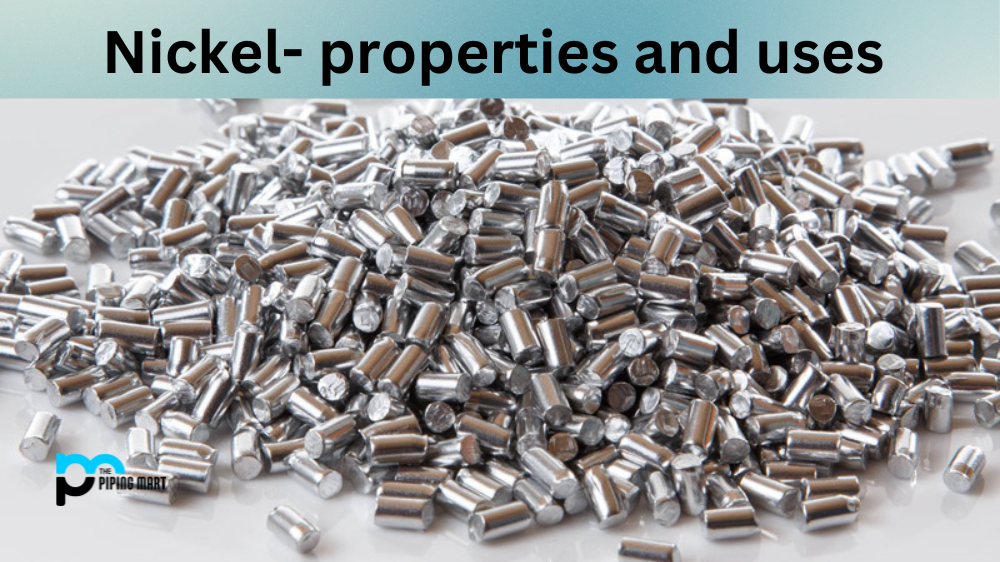Nickel is a silvery-white metal with a slight golden tinge that takes on a high polish. It is one of only four elements that are magnetic at or near room temperature, the others being iron, cobalt, and gadolinium. Its Curie temperature of nickel is 355 °C (671 °F), meaning nickel is non-magnetic above this temperature. The unit cell of nickel is face-centered cubic and has the lattice parameter of 0.352 nm, reflecting its strong metallic character. This crystal structure of nickel is stable up to 522 °C (975 °F) before it starts to transform to body-centered cubic above this temperate. Nickel shows significant chemical activity; it corrodes slowly in moist air and rapidly when exposed to hydrogen sulfide.
What is Nickel?
Nickel is a silvery-white metal that is incredibly durable and has a beautiful sheen. It is classified as a transition metal because of its ability to accept and donate electrons to other elements. Nickel has an atomic mass of 58.69, which makes it one of the heavier elements on the periodic table. The nickel HSN code is 7405, giving nickel recognition in countries that use the HSN system for import/export classification. Additionally, nickel is often used in jewelry due to its color and strong qualities; nickel allergies are also common because nickel particles are so tiny that they can be absorbed through the skin.
Physical properties of nickel metal
Nickel is a silvery-white metal that is incredibly ductile and malleable, allowing it to be easily shaped and molded into whatever form it needs to be. Its physical properties also make it an excellent electrical conductor, making it ideal for use in many electrical components. One of the more unique physical properties of nickel is its magnetic properties. It has a tendency to be attracted to strong magnets, which makes it popular in consumer electronics and tools. Nickel also has outstanding resistance against corrosion when exposed to seawater, making it highly useful in industrial applications. Ultimately, these physical properties demonstrate why nickel is one of the most sought-after metals in modern industry.
- Nickel is a silvery-white metal that is found in the Earth’s crust.
- Nickel is classified as a transition metal and is located in the periodic table between iron and cobalt.
- Nickel is a relatively soft metal with a low melting point.
- Nickel is magnetic and has a relatively high electrical conductivity.
- Nickel is resistant to corrosion and is often used in stainless steel alloys.
- Nickel can be found in coins, jewelry, and other objects.
Chemical properties of nickel metal
Nickel is a silvery-white metal that stands out for its chemical properties. It has an atomic number of 28 and an atomic weight of nickel is 58.69 g/mol. Nickel is highly malleable and ductile, making it useful for creating various shapes with relatively little effort. Its melting point is 1455°C, which again lends itself to its malleability. Also notable is nickel’s high resistance to corrosion, especially in moist environments; this helps explain why it’s alloyed with many metals to form casings or fixtures suitable for use both outdoors and indoors. Nickel also takes on some interesting properties in the air – organic vapors can cause it to turn yellow, while sulfides cause it to turn both gray and black over time as they oxidize. In summary, nickel offers a balance of malleability, corrosion resistance, unique appearance changes, and relative costs when compared to other transition metals, making it appealing for many purposes.
- Nickel is a silvery-white metal that is found in the Earth’s crust.
- Nickel is abundant in the Earth’s crust and is thought to be an essential element for life.
- Nickel is mostly used in the production of stainless steel and other alloys.
- Nickel is also used in the production of batteries, coins, and jewelry.
- Nickel is considered a transition metal on the periodic table.
- The chemical symbol for nickel is Ni, and its atomic number is 28.
- The melting point of nickel is 1453 degrees Celsius, and its boiling point is 2913 degrees Celsius.
Uses of Nickel
Nickel is one of the most useful metals we can find on Earth, and it plays a crucial role in various industries. Nickel is used to creating coins, alloys for aircraft engines and turbine blades, nickel-based batteries for electric vehicles, and stainless steel appliances like fridges and dishwashers. Because it resists corrosion so well, nickel is also used as a coating for propellers and other parts situated below the waterline that is particularly vulnerable to erosion. Furthermore, nickel-based catalysts have been developed for use in refining oil and producing fuels. This versatile metal has been integral to industry for centuries and will undoubtedly keep powering the world for quite some time.
- Production of stainless steel.
- Coins.
- Batteries.
- Magnets.
- Catalysts.
- Paint and varnish.
- Dyes.
- Ceramics.
- Glass.
- welding rod

Pipingmart is a B2B portal that specializes in metal, industrial and piping items. Additionally, we share the latest information and information about materials, products and various types of grades to assist businesses that are involved in this business.




